2003 PONTIAC BONNEVILLE child lock
[x] Cancel search: child lockPage 2 of 418
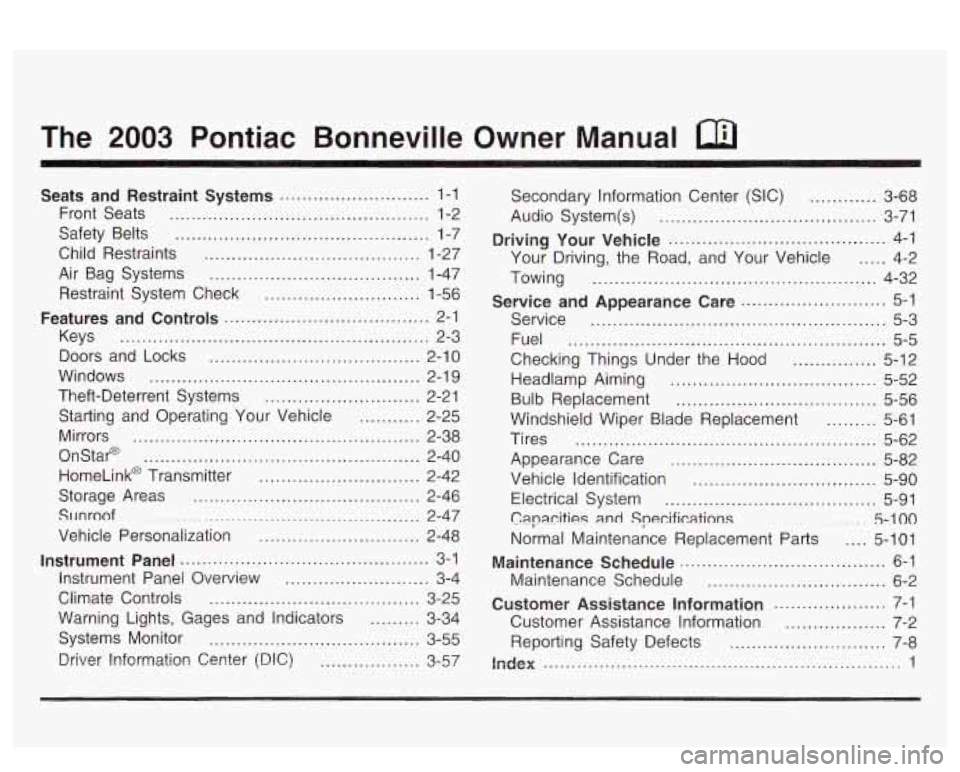
The 2003 Pontiac Bonneville Owner Manual
Seats and Restraint Systems ........................... 1-1
Front Seats
............................................... 1-2
Safety Belts
.............................................. 1-7
Child Restraints
....................................... 1-27
Air Bag Systems
...................................... 1-47
Restraint System Check
............................ 1-56
Features and Controls ..................................... 2-1
Keys
........................................................ 2-3
Doors and Locks
...................................... 2-10
Windows
................................................. 2-1 9
Theft-Deterrent Systems
............................ 2-21
Starting and Operating Your Vehicle
........... 2-25
Mirrors
.................................................... 2-38
OnStap
.................................................. 2-40
HomeLink@ Transmitter
............................. 2-42
Storage Areas
......................................... 2-46
SlJnroof
................................................. 2-47
Vehicle Personalization
............................. 2-48
Instrument Panel ............................................. 3-1
Instrument Panel Overview
.......................... 3-4
Climate Controls
...................................... 3-25
Warning Lights, Gages and Indicators
......... 3-34
Systems Monitor
...................................... 3-55
Driver Information Center (DIC)
.................. 3-57 Secondary
Information Center (SIC)
............ 3-68
Audio System(s)
....................................... 3-71
Driving Your Vehicle ....................................... 4-1
Your Driving, the Road, and Your Vehicle
..... 4-2
Towing
................................................... 4-32
Service
..................................................... 5-3
Fuel
......................................................... 5-5
Checking Things Under the Hood
............... 5-12
Headlamp Aiming
..................................... 5-52
Bulb Replacement
.................................... 5-56
Windshield Wiper Blade Replacement
......... 5-61
Tires
...................................................... 5-62
Appearance Care
..................................... 5-82
Vehicle Identification
................................. 5-90
Electrical System
...................................... 5-91
C8pa.citigs
and Specifications ......... 5-100
Normal Maintenance Replacement Parts .... 5-101
Maintenance Schedule
................................ 6-2
Customer Assistance Information .................... 7-1
Customer Assistance Information
.................. 7-2
Reporting Safety Defects
............................ 7-8
index ................................................................ 1
Service and Appearance Care .......................... 5-1
Maintenance Schedule ..................................... 6-1
Page 6 of 418
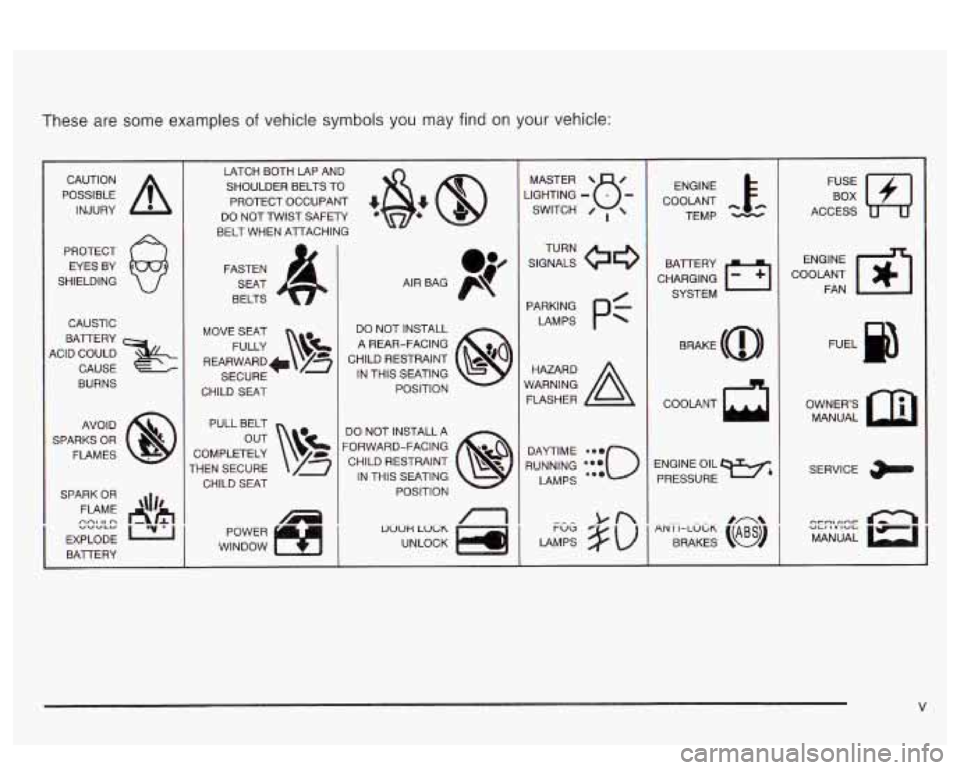
These are some examples of vehicle symbols you may find on your vehicle:
POSSIBLE A
CAUTION
INJURY
PROTECT EYES BY
SHIELDING
CAUSTIC
KID COULD
&
BATTERY
CAUSE
BURNS
AVO ID
SPARKS OR
FLAMES
SPARK OR
FLAME '\I/'
EXPLODE L22
BAlTERY
nnl It n "VVLY
1
LATCH BOTH LAP AND
SHOULDER BELTS TO
PROTECT OCCUPANT
*@? @
DO NOT TWIST SAFETY
BELT WHEN ATTACHING
FASTEN
SEAT
BELTS
MOVE SEAT
FULLY
\!&
REARWARD+ /z
SECURE
CHILD
SEAT
PULL BELT
COMPLETELY
THEN SECURE CHILD SEAT
WINDOW POWER
1
I
f
1
DO NOT INSTALL
A REAR-FACING
CHILD RESTRAINT IN THIS SEATING
POSITION
DO NOT INSTALL A
'ORWARD-FACING CHILD RESTRAINT
IN THIS SEATING
POSITION
uoon LOCK
UNLOCK
/17
I
1
JGHTING - MASTER SWITCH 8- 0 ,
RUNNING ***o
DAYTIME e-.
LAMPS ...
ENGINE
COOLANT TEMP
CHARGING
L-1
BAlTERY SYSTEM
BRAKE
(@)
COOLANT
ENGINE OIL
PRESSURE
w4
l.fJ
ACCESS
ENGINE
COOLANT FAN
OWNERS MANUAL
SERVICE
Page 19 of 418
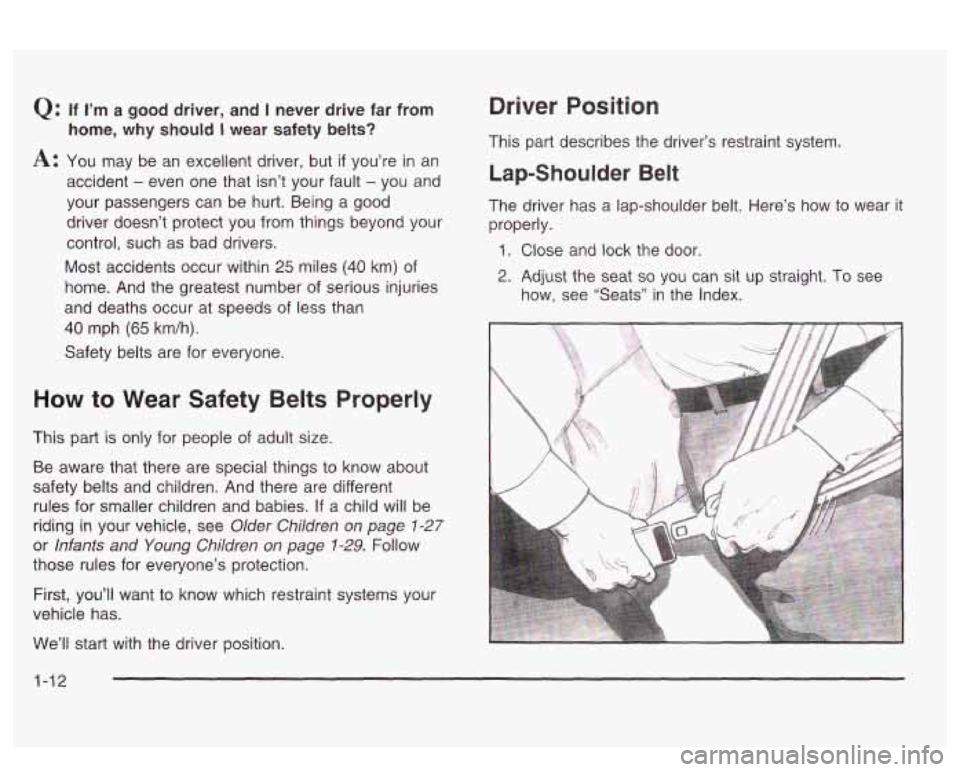
Q: If I’m a good driver, and I never drive far from
At You may be an excellent driver, but if you’re in an
accident
- even one that isn’t your fault - you and
your passengers can be hurt. Being a good
driver doesn’t protect you from things beyond your
control, such as bad drivers.
Most accidents occur within
25 miles (40 km) of
home. And the greatest number of serious injuries
and deaths occur at speeds of less than
40 mph (65 km/h).
Safety belts are for everyone.
home, why should I wear safety belts?
How to Wear Safety Belts Properly
This part is only for people of adult size.
Be aware that there are special things to know about
safety belts and children. And there are different
rules for smaller children and babies.
If a child will be
riding in your vehicle, see
Older Children on page 7-27
or lnfants and Young Children on page 1-29. Follow
those rules for everyone’s protection.
First, you’ll want to know which restraint systems your
vehicle has.
We’ll start with the driver position.
Driver Position
This part describes the driver’s restraint system.
Lap-Shoulder Belt
The driver has a lap-shoulder belt. Here’s how to wear it
properly.
1. Close and lock the door.
2. Adjust the seat so you can sit up straight. To see
how, see “Seats’’ in the Index.
1-12
Page 26 of 418
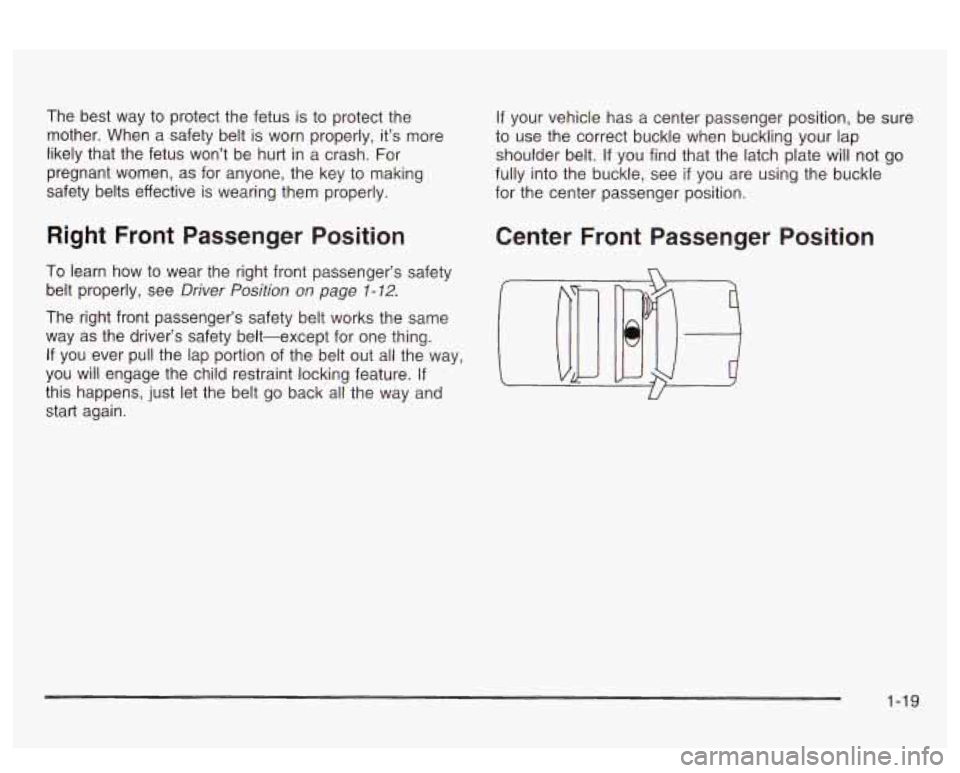
The best way to protect the fetus is to protect the
mother. When a safety belt is worn properly, it’s more
likely that the fetus won’t be hurt
in a crash. For
pregnant women, as for anyone, the key to making
safety belts effective is wearing them properly.
Right Front Passenger Position
To learn how to wear the right front passenger’s safety
belt properly, see
Driver Position on page 1-72.
The right front passenger’s safety belt works the same
way as the driver’s safety belt-except for one thing.
If you ever pull the lap portion of the belt out all the way,
you will engage the child restraint locking feature.
If
this happens, just let the belt go back all the way and
start again.
If your vehicle has a center passenger position, be sure
to use the correct buckle when buckling your lap
shoulder belt.
If you find that the latch plate will not go
fully into the buckle, see
if you are using the buckle
for the center passenger position.
Center Front Passenger Position
1-19
Page 75 of 418
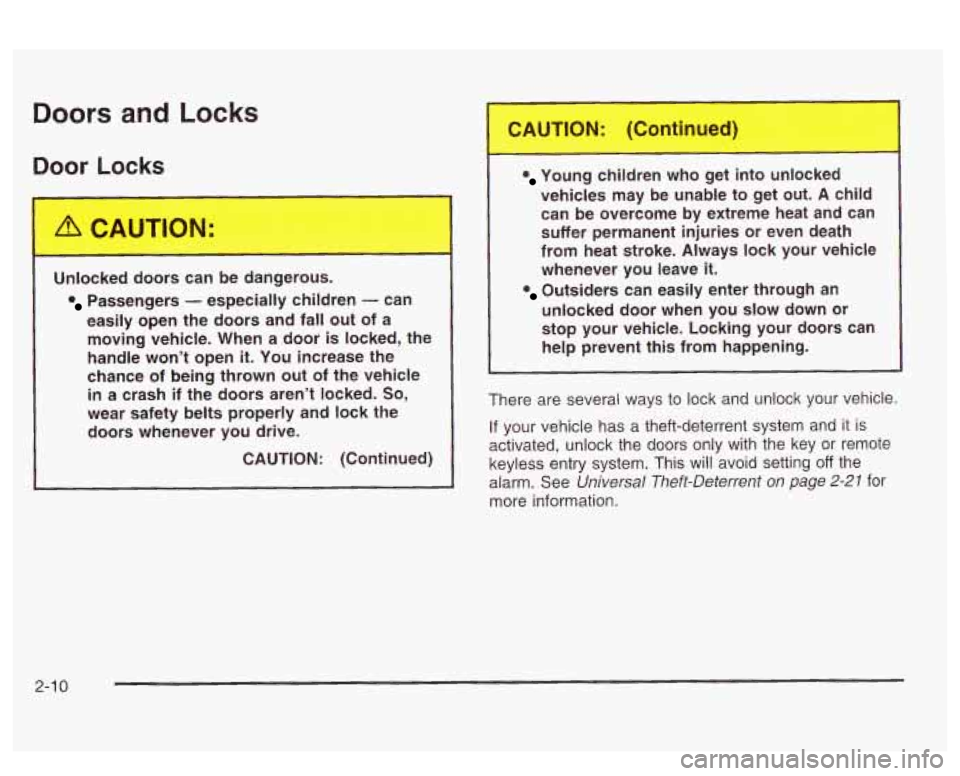
Doors and Locks
Door Locks
Unlc,.
easily open the doors and fall out of a moving vehicle. When a door
is locked, the
handle won’t open
it. You increase the
chance of being thrown out of the vehicle
in a crash if the doors aren’t locked. So,
wear safety belts properly and lock the
doors whenever you drive.
CAUTION: (Continued)
Young children who get into unlocked
vehicles may be unable to get out.
A child
can be overcome by extreme heat and can
suffer permanent injuries or even death
from heat stroke. Always lock your vehicle
whenever you leave
it.
unlocked door when you slow down or
stop your vehicle. Locking your doors can
help prevent this from happening.
Outsiders can easily enter through an
There are several ways to lock and unlock your vehicle.
If your vehicle has a theft-deterrent system and it is
activated, unlock the doors only with the key or remote
keyless entry system. This will avoid setting
off the
alarm. See
Universal Theft-Deterrent on page 2-27 for
more information.
2-1 0
Page 80 of 418
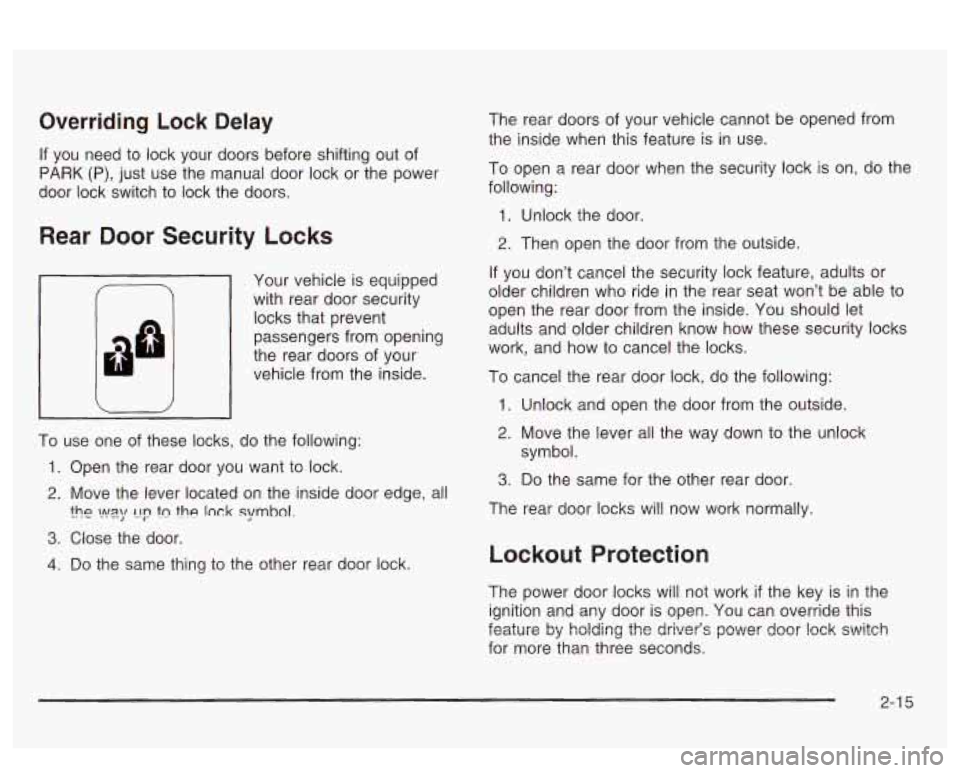
Overriding Lock Delay
If you need to lock your doors before shifting out of
PARK (P), just use the manual door lock or the power
door lock switch to lock the doors.
Rear Door Security Locks
I
Your vehicle is equipped
with rear door security
locks that prevent
passengers from opening
the rear doors of your
vehicle from the inside.
To use one of these locks, do the following:
1. Open the rear door you want to lock.
2. Move the lever located on the inside door edge, all
3. Close the door.
?he vyq 1-19 tn the lnck symhol.
4. Do the same thing to the other rear door lock. The
rear doors of your vehicle cannot be opened from
the inside when this feature is in use.
To open a rear door when the security lock is on, do the
following:
1. Unlock the door.
2. Then open the door from the outside.
If you don’t cancel the security lock feature, adults or
older children who ride
in the rear seat won’t be able to
open the rear door from the inside. You should let
adults and older children know how these security locks
work, and how to cancel the locks.
To cancel the rear door lock, do the following:
1. Unlock and open the door from the outside.
2. Move the lever all the way down to the unlock
3. Do the same for the other rear door.
symbol.
The rear door locks will now work normally.
Lockout Protection
The power door locks will not work if the key is in the
ignition and any door is open. You can override this
for more than three seconds.
Fnr.+, It;arul& ,r bj holdi~g the driver’s newer IJ deer !ock ssvitch
2-1 5
Page 229 of 418
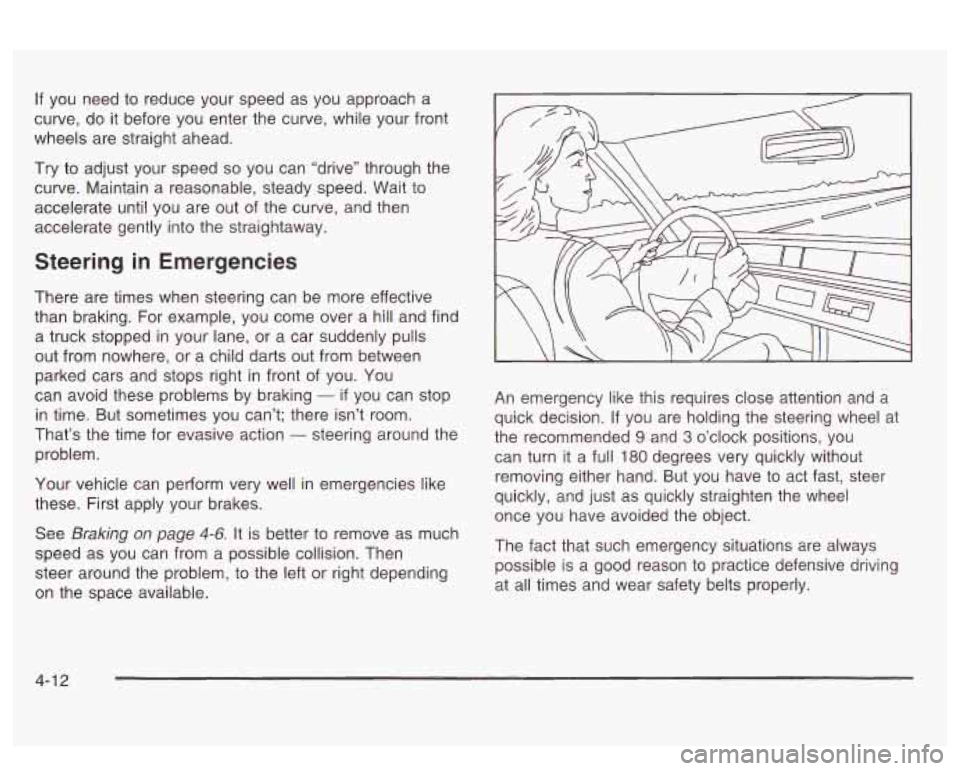
If you need to reduce your speed as you approach a
curve, do it before you enter the curve, while your front
wheels are straight ahead.
Try
to adjust your speed so you can “drive” through the
curve. Maintain a reasonable, steady speed. Wait to
accelerate until you are out of the curve, and then
accelerate gently into the straightaway.
Steering in Emergencies
There are times when steering can be more effective
than braking. For example, you come over a hill and find
a truck stopped in your lane, or a car suddenly pulls
out from nowhere, or a child darts out from between
parked cars and stops right in front of you. You
can avoid these problems by braking
- if you can stop
in time. But sometimes you can’t; there isn’t room.
That’s the time for evasive action
- steering around the
problem.
Your vehicle can perform very well in emergencies like
these. First apply your brakes.
See
Braking on page 4-6. It is better to remove as much
speed as you can from a possible collision. Then
steer around the problem, to the left or right depending
on the space available. An emergency
like this requires close attention and
a
quick decision. If you are holding the steering wheel at
the recommended
9 and 3 o’clock positions, you
can turn it
a full 180 degrees very quickly without
removing either hand. But you have
to act fast, steer
quickly, and just as quickly straighten the wheel
once you have avoided the object.
The fact that such emergency situations are always
possible is a good reason
to practice defensive driving
at all times and wear safety belts properly.
4-1 3
Page 406 of 418
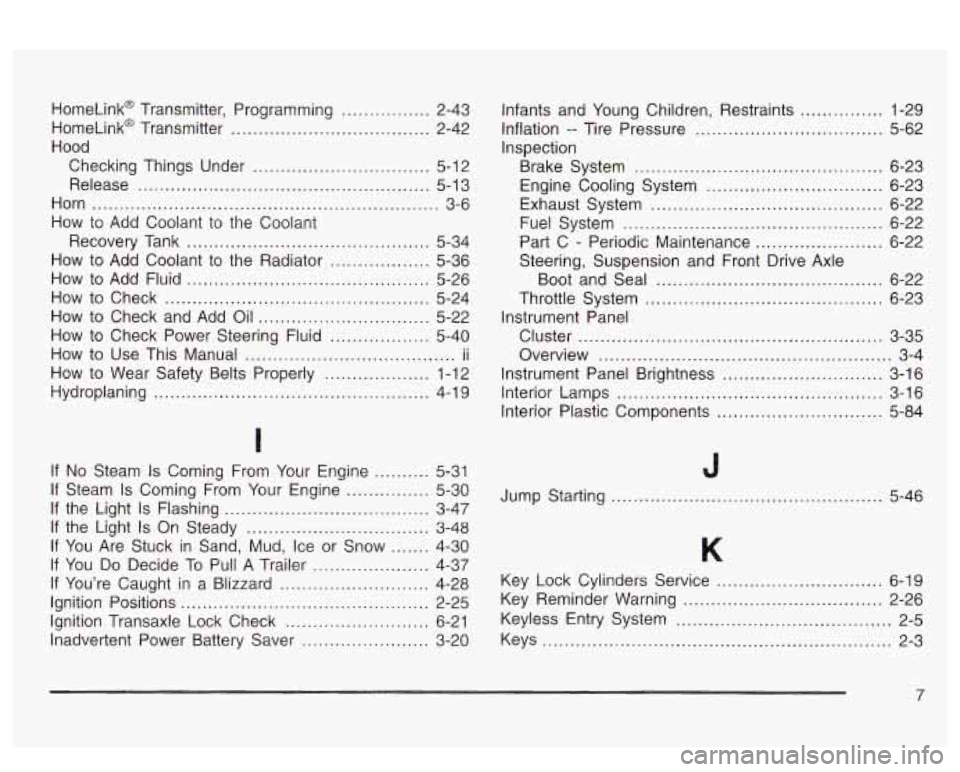
HomeLink@ Transmitter. Programming ................ 2-43
HomeLink@ Transmitter
.................................... 2-42
Hood Checking Things Under
................................ 5-12
Release
..................................................... 5-1 3
Horn
............................................................... 3-6
How to Add Coolant to the Coolant
How to Add Coolant to the Radiator
.................. 5-36
How to Add Fluid
............................................ 5-26
How to Check
................................................ 5-24
How
to Check and Add Oil ............................... 5-22
How to Check Power Steering Fluid
.................. 5-40
How to Use This Manual
...................................... ii
How to Wear Safety Belts Properly ................... 1-12
Hydroplaning
.................................................. 4-1 9
Recovery Tank ............................................ 5-34 Infants
and Young Children. Restraints
............... 1-29
Inflation
.. Tire Pressure .................................. 5-62
Inspection Brake System
............................................. 6-23
Exhaust System
.......................................... 6-22
Fuel System
............................................... 6-22
Part C
- Periodic Maintenance ....................... 6-22
Steering, Suspension and Front Drive Axle
Boot and Seal
......................................... 6-22
Throttle System
........................................... 6-23
Cluster
....................................................... 3-35
Overview
..................................................... 3-4
Instrument Panel Brightness
............................. 3-16
Interior Lamps
................................................ 3-16
Interior Plastic Components
........................... 5-84
Engine Cooling
System
................................ 6-23
Instrument Panel
If No Steam Is Coming From Your Engine .......... 5-31 J
If Steam 1s Coming From Your Engine ............... 5-30 Jump Starting ............................ If the Light Is Flashing ..................................... 3-47 ... 5-46
.
If the Light Is On Steady ................................. 3-48
If You Are Stuck in Sand, Mud, Ice or Snow ....... 4-30
If You Do Decide To Pull A Trailer ..................... 4-37
If You’re Caught in a Blizzard ........................... 4-28 Key Lock Cylinders Service .......................... 6-19
Ignition Positions
............................................. 2-25 Key Fkminder Warning .................................... 2-26
Ignition Transaxle Lock Check
.......................... 6-21 Keyless Entry System ....................................... 2-5
K
Inadvertent Power Battery Saver .................... 3-20 Keys ............................................................... 2-3
7